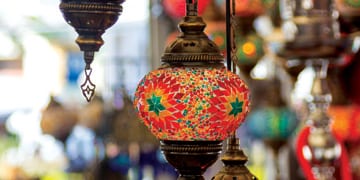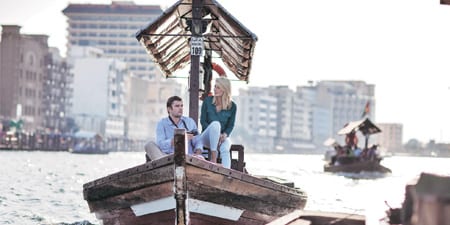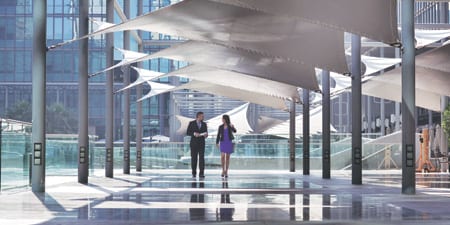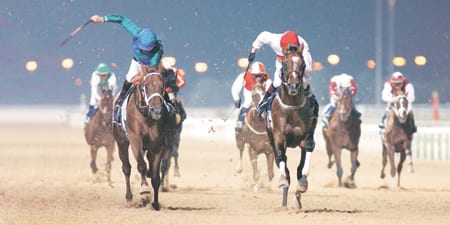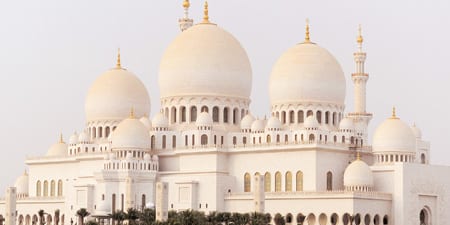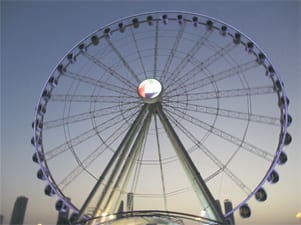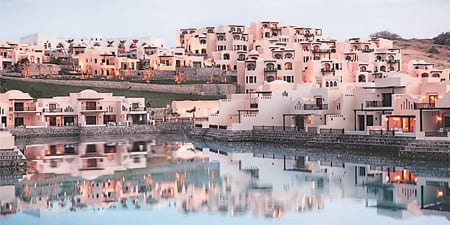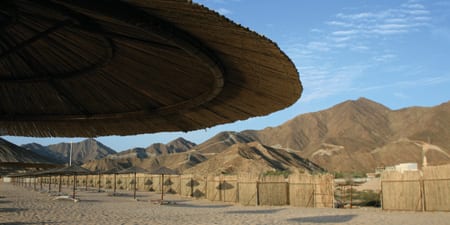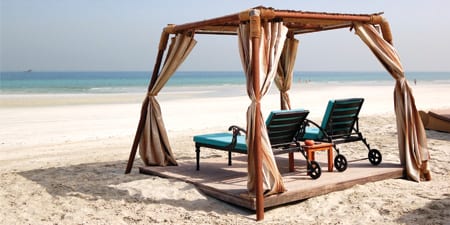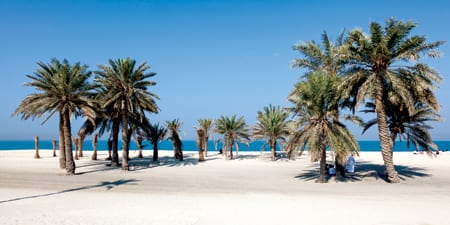Rediscovering The Emirates
The seven Emirates that make up the UAE have reinvented themselves to offer a mix of traditional and contemporary tourism products – from art festivals and falconry to light and sound shows, hot air ballooning and sailing. These are just a few of the niche products that await the discerning traveller visiting the UAE
Arabian Travel Market 2015
Dubai
Dubai’s many top line events, from musical extravaganzas to sporting spectacles, have established the city as the events’ capital of the Middle East, North Africa and Southeast Asia
Dubai plays host to some of the most happening events in this part of the world, ranging from arts and sports, food and books to music and lights, heritage and fashion. Thanks to its strategic location between the east and the west, coupled with its infrastructural support and amenities, and the requirement to entertain a population drawn from 200 nationalities, the city has become the focal point of major events that attract the world’s best.
Events capital
Dubai is increasingly a top stop for A-list musicians and performers on their world tours. Bruno Mars, Eric Clapton, Justin Bieber, The Killers, Deep Purple and Alicia Keys are just a handful of acts to have played on Dubai’s stages in recent times, not to mention the dozens of Bollywood and Arabic superstars for whom the emirate is a second home.
As a city that attracts, nurtures and encourages talent, Dubai has become the regional hub for art, gastronomy, literature and film. Each year the annual literary festival draws top-selling regional and international authors and commentators and under the umbrella of The Dubai Art Season numerous events showcase homegrown Emirati and Dubai-based artistic talent, turning the whole city into an eclectic gallery and providing a perfect platform for international designers to meet. The season culminates with the Gulf Film Festival, the baby sister to the annual Dubai International Film Festival (DIFF) that takes place each December.
In 2014 the Dubai Food Festival was launched. This month-long gastronomic extravaganza saw restaurants set up on the beach; welcomed celebrity chefs who flew in to give master classes; invited the public to taste signature dishes from the city’s top restaurants; and served up cooking contests and family entertainment all in the name of food.
Also new to the calendar in 2014 was the Dubai Tour, a three-day event when the streets were cleared to make way for the world’s top cycling professionals. Several weekend music festivals were launched too, including Classics, Blended and Redfest. These joined old favourites, such as the Emirates Airline Dubai Jazz Festival, which has been held each February since 2003. And with venues such as Nasimi Beach, where thousands gather on the beach at Atlantis, The Palm; Dubai Media City Amphitheatre, where the skyscrapers of Media City and Dubai Marina overlook a purpose-built, 15,000 person arena; and Dubai Festival City, which stages world-class concerts on the shores of Dubai Creek; the combination of acts and environments make for memorable experiences.
Several events throughout the year depend on public participation, like the Dubai Marathon when over 22,000 runners pound the streets from Burj Khalifa all along the Beach Road; or the Spinney’s Dubai 92 Cycle Challenge when 2,000 amateur cyclists peddle around Dubai’s iconic landmarks for 92 km. Participants from across the globe unite at the start and meet again at the finish lines in these fun and lively events.
These events may be relatively new, but there are many festivals that have been going for so long that they are now ingrained in Dubai’s diary. The Dubai Shopping Festival (DSF) is a prime example. Celebrating its 20th anniversary in 2015, DSF is not only a shopping extravaganza, but also a huge family entertainment extravaganza when all visitors and residents in Dubai enjoy non-stop competitions – which come with jaw-dropping prizes – and a packed schedule of theatrical shows and entertainment.
Also long established are those events that capture the true spirit and culture of the emirates. Each May you’ll see the spectacular sight of hundreds of traditional Arabian dhows with their billowing white sails grace the Arabian Gulf as they race along the Dubai coast in the Al Gaffal Traditional Dhow Sailing Race paying tribute to Dubai’s pearl-trading past. And of course, Ramadan is a time when the whole city comes together to celebrate, contemplate and rejoice. This is an awakening experience for everyone – including non-Muslims – and all are welcome to join in the celebratory feasts each evening and enjoy the Holy Month.
Sports lovers’ paradise
The city’s facilities are world-class and the venues have been purpose built for sporting events. Tiger Woods and Rory McIlroy regularly appear on the first tee at the Omega Dubai Desert Classic each year at the Emirates Golf Club; Federer, Nadal, Djokovic, Murray and the Williams sisters are no strangers on the courts at the Dubai Duty Free Tennis Championships; the Dubai International Cricket Stadium was the host of the Indian Premier League during its 2014 season; and the city’s polo fields attract the kings of this regal sport at the annual Dubai Gold Cup. And each year the world’s leading jockeys and horses bid to be in the winner’s circle at the showpiece Dubai World Cup.
For golfers Dubai is paradise. Dubai has 11 outstanding courses, many designed by professionals such as Colin Montgomerie, Ernie Els and Nick Faldo. The most famous is the Majlis course at the Emirates Golf Club, the annual host to the renowned Omega Desert Classic where the likes of Tiger Woods and Rory Mcllroy have lifted the Classic trophy. The Jumeirah Golf Estates hosts the climax to the Race to Dubai.
Those travellers interested in mounting a horse should head to any of the equestrian centres, such as Emirates Equestrian Centre or Club Joumana at the Jebel Ali Equestrian Club. For a truly Dubai equestrian experience they can go to the desert – The Al Sahra Desert Resort Equestrian Centre or Al Jiyad Stables are among the liveries that offer the remarkable desert experience. For horse-riding with a twist, there’s nothing like polo to get the adrenaline pumping. Even complete novice riders can try out this ‘sport of kings’ at any of the city’s polo clubs, including the Dubai Polo Club at Desert Palm Retreat – home to the Cartier International Dubai Polo Challenge; and Dubai Polo and Equestrian Club at Arabian Ranches, host to the Dubai Polo Gold Cup. And of course there’s always camel polo for an Arabian twist on this regal sport.
For adventure junkies sand boarding is an interesting option at Dubai’s Big Red dune – the emirate’s ultimate ‘black run’. This mountain, just a 30-minute drive from Dubai towards Hatta, rises to 300 ft. Hot air balloon provides a magical opportunity to experience the beauty of the desert at sunset or sunrise. A high-rise experience above the desert – albeit of a slightly faster kind – is also offered by Skydive Dubai from its desert campus at Margham. Alternatively, opt for another equally unique view – that of Dubai’s Palm Jumeirah.
For those who prefer sticking to terra firma, then increasingly one of the popular ways to explore the city is on two wheels. Dubai’s cycling scene has gathered some serious momentum over the past few years. Particularly popular are the The Nad Al Sheba Cycle Park, with its choice of eight, six and four km loops with the whole course lit by night, and the 68 km desert ‘Lollipop’ track through the desert – with a particularly welcome spot at the luxurious Bab al Shams desert resort.
For professional cyclists, Dubai laid down the challenge in February 2014 in the form of the four-day Dubai Tour. Hundreds of the world’s top cyclists – including the eventual winner Taylor Phinney – pelted around the city, in what opponent Marcel Kittel described as “the fastest sightseeing tour ever”.
Abu Dhabi
Offering both traditional and modern attractions, Abu Dhabi, has become a favourite destination for Indian travellers, resulting in the country becoming the number one source market for Abu Dhabi. Looking at the rising tourist numbers, the board is targeting to continue the current growth performance with a sustained rise
Abu Dhabi Tourism & Culture Authority (TCA Abu Dhabi) is attracting Indian outbound travellers with multi-faceted attractions. India is currently Abu Dhabi’s leading overseas source market for hotel guests. Abu Dhabi welcomed 231,702 Indian hotel guests in 2014 at a growth rate of 32 per cent over 2013. There were 850,443 guest nights in 2014, at a growth rate of 23 per cent over 2013.

Abu Dhabi offers both traditional and modern attractions. The key segments are leisure, special interest, destination wedding and honeymoon, niche travellers and MICE. Bejan Dinshaw, country manager, India, TCA Abu Dhabi says, “We are attracting a large number of incentive and conferences business travellers with our Abu Dhabi Convention Bureau’s Advantage Abu Dhabi incentive programmes – where meeting planners can get help, financial and other, if they bring viable business events to the destination. Applications for Advantage Abu Dhabi can be made on the bureau’s website – www.abudhabi-cb.ae – and should be aligned to 12 specific economic engine sectors identified in Abu Dhabi’s 2030 economic vision.”
Tourism products
One of Abu Dhabi’s most iconic landmarks is the famous Sheikh Zayed Grand Mosque, named by TripAdvisor’s Travellers’ Choice awards as the world’s second most sought after landmark. Emirates Palace – one of the world’s most opulent hotels – is a must-visit property for its opulence and luxury quotient. With a vast range of attractions for the whole family, Abu Dhabi’s Yas Island is becoming increasingly popular among Indian travellers as a complete entertainment destination. There are multiple attractions, including Ferrari World Abu Dhabi, the world’s only Ferrari-branded theme park with more than 20 rides and the world’s fastest rollercoaster, Formula Rossa, reaching speeds up to 240 kmph. F1 fans can have a thrilling experience with the state-of-the-art F1 track at Yas Marina Circuit, where petrol heads can drive a Formula Yas 3000 or Aston Martin GT4 around the same circuit as the pros. Yas Waterworld – featuring 43 rides, slides and attractions spanning a sprawling 15-hectares – is an award-winning water park and there’s Yas Links, a championship-level 18 holes Links course, which was voted among the world’s top 25 courses outside of the US.
The long-awaited Yas Mall is now open. It has more than 370 stores and is only five minutes from Abu Dhabi International Airport and 15 minutes from downtown Abu Dhabi. Abu Dhabi’s shopping is tax-free. Yas Mall also has a direct link to Ferrari World Abu Dhabi, thereby opening up a range of entertainment options.
Abu Dhabi is also attracting art and culture lovers with the fast developing Saadiyat Island Cultural District. With its sweeping beach, Saadiyat Beach Golf Club and stunning beachfront resorts, Saadiyat Island will soon be home to a series of world-class cultural institutions. The Jean Nouvel-designed Louvre Abu Dhabi will open this year, followed by the Zayed National Museum next year and the Guggenheim Abu Dhabi in 2017.
Focus on India market
TCA Abu Dhabi capped off a very successful 2014 with a number of activities promoting the destination. Many travel trade workshops were held in Delhi, Mumbai, Chennai, Bengaluru and Ahmedabad. “We have also conducted similar workshops in the beginning of 2015 in Chandigarh, Lucknow and Kolkata. We are continuing the endeavour for greater networking with the popular Evening with Abu Dhabi, which has taken place in Goa and Pune most recently,” he mentions.
The board also received a favourable response in the B2B fairs that they participated during 2014-15. “We are undertaking joint destination familiarisation trips and marketing initiatives with our national carrier Etihad Airways. Our primary focus for all marketing activities is to project Abu Dhabi as a unique destination with attractions and opportunities to indulge in and enjoy with the whole family,” adds Dinshaw.
Sharjah
Sharjah, the Capital of Arab Tourism for 2015, is a destination that showcases with pride its cultural heritage and imposing edifices of modern Islamic architecture
Just half an hour drive from Dubai is the emirate of Sharjah, which has been selected as the Capital of Arab Tourism for 2015. Sharjah has a rich cultural legacy that is well presented in its 16 museums, along with a grand architectural heritage and many more attractions that could be a great draw for tourists from across the world.
City of Museums
It is evident that Sharjah is a destination that takes great pride in its heritage and culture – the concept might be new, but the true essence of the land is beautifully interwoven in the thematic presentations. So whether it is the spectacular visuals of the Sharjah Light Festival on heritage buildings in the city or the Sharjah Aquarium and Maritime Museum, every tourism attraction presents a flow of continuity from the past to the present. Sharjah could in fact be called a city of museums. The aquarium acquaints visitors with the marine life found in the waters of the region – from the ocean to rock pools and lagoons. It also highlights the life and times of the traditional fishing communities.
Located nearby is the Sharjah Maritime Museum that is an interesting showcase of the emirate’s maritime history. The grandest of all is the Sharjah Museum of Islamic Civilisation, which is housed in an impressive building that complements well the rich repository inside. A visit to the museum is a must and gives an interesting insight into Islam, history of its spread across the world, the art and science associated with it, and many lesser known significant facts that very few people are aware of. The other 14 museums include Sharjah Calligraphy Museum, Sharjah Heritage Museum, Sharjah Science Museum, Sharjah Archeology Museum, Sharjah Classic Cars Museum, Sharjah Discovery Centre, and others.
Heart of Sharjah is the oldest part of the city where homes built with corals brought from the creek in olden times have been painstakingly restored to give the modern visitor a peep into the life in those times. Adjacent to it is the Souq Al Arsa, which is the oldest market in Sharjah, where you can buy interesting bric a bracs. The Central Souk is another heritage precinct, where tourists can buy gold and souvenirs. It is a perfect place to strike a bargain.
The emirate also has many mosques – from the large Al Noor Mosque to many smaller ones, where the faithful congregate several times everyday. These mosques in many ways define the skyline of Sharjah – most are beautiful beige coloured structures with large domes and towering minarets. One of the most magnificent is the Al Noor Mosque. It has been inspired by the Blue Mosque in Istanbul.
Events and festivals
In the month of February, for nine days the Sharjah Light Festival transforms the historic buildings in the emirate into breathtaking platforms of visual display. The music and the ambience lend almost a magical touch to this unique festival.
The Sharjah International Show jumping championship is held in the month of January. It is a platform for UAE’s best show jumping stars to showcase their skills and compete for the grand prize money. The participants come from many countries. Another important equestrian event is the Sharjah International Arabian Horse Festival that highlights the important position that these magnificent animals have in Arab culture and heritage.
Sharjah Heritage Days is an event that celebrates the culture of the land. While the Al Qasba Food Festival is a big draw for food lovers and the Ramadan & Summer Shopping Festival is 10 weeks of fun and entertainment.
Ras Al Khaimah
With an aim to promote itself as an affordable luxury standalone tourism destination in the emirate, the Ral Al Khaimah (RAK) government has attracted investments from major international hotel brands
The Emirate of Ras Al Khaimah is one of the seven emirates which together comprise of the federation of the United Arab Emirates (UAE). The federation was established on December 2, 1971, which included Abu Dhabi, Dubai, Sharjah, Ajman, Umm Al Qawain and Fujairah, where Ras Al Khaimah joined by February 1972. The emirate’s unique combination of desert, mountains and natural coastline makes Ras Al Khaimah an ideal environment for outdoor activities and relaxation. Visitors to the emirate can enjoy various outdoor activities from swimming, fishing and golfing to exploring the desert by safari and experiencing a traditional Bedouin desert camp or enjoying the water slides at Iceland Water Park.
With an aim to promote itself as an affordable luxury standalone tourism destination in the emirate, the Ral Al Khaimah (RAK) government has attracted investments from major international hotel brands for its Al Marjan Island project. Said to be one of their biggest projects, the island has already witnessed the opening of major hotel brands namely- 650 keys Rixos Al Bahr Resort; the 301-room Marjan Island Resort & Spa; the 484-key DoubleTree by Hilton Resort & Spa, Marjan Island and the 346 room Ras Al Khaimah Waldorf Astoria. In 2015, the island will also witness the opening of the 265-room Santorini Hotel, a part of The Bin Majid Group. Mohamed Khater, business development manager, Government of Ras Al Khaimah said, “Presently the destination has 5,200 room inventory, but the target is to reach 10,000 rooms by 2020. We are also looking at developing resort properties in the mountain areas and developing tourist attractions as well.”
India focus
The Ras Al Khaimah Tourism Authority is targeting leisure, honeymoon and MICE travellers from the India market. The top five source markets of the destination include UAE, Germany, Russia, UK and India. As part of its tourism offerings, the department is promoting Al Hamra Golf Club, Tower Links Golf Club, Ras Al Khaimah Country Club for golf lovers, water sports adventure activities at RAK Sailing Academy, adventure sports, catamaran yacht, and the desert safari. For leisure travellers- Iceland Water Park, Al Hamra Marina & Royal Yacht Club, Falcon Show, Jazirah Aviation Club and Pearl Excursions. Besides this, the department is also offering experiences at Bassata Desert Village, Bedouin Oasis Desert Camp, Prince of Sea, Seawings, National Museum of Ras Al Khaimah, Dhayah Fort and Jazirat Al Hamra.
When asked about the tourist arrivals to the destination, Khater informed, “In 2013, the destination witnessed a total guest nights of 1.2 million and in the future the department is looking at achieving two million guest nights.” In order to achieve their targets, the department is looking at working closely with the travel trade in India. They will also organise seminars, workshops, FAM trips and will participate at important trade fairs.
In terms of direct flight connectivity, Khater mentioned that Air Arabia, the official carrier of Ras Al Khaimah and an LCC in the Middle East and North Africa, is also looking at starting four times a week direct flight from Calicut in the near future. Presently the airline offers connectivity to Ras Al Khaimah via Sharjah from 13 cities in India – Mumbai, Goa, Nagpur, Delhi, Ahmedabad, Chennai, Bengaluru, Hyderabad, Jaipur, Thiruvanathapuram, Kochi, Kozikhode and Coimbatore.
Fujairah
Being rich in archeological treasures, the Emirate of Fujairah highlights pristine natural heritage along with abundance of castles, forts, towers and mosques, some even dating back to about five centuries
Nestled between the Hajar Mountains and the Indian Ocean, Fujairah, situated on the east coast of the United Arab Emirates, is a popular holiday destination, especially due to its location of being the only emirate to not have its coastline along the Arabian Gulf but being on the eastern side of the UAE, the beaches of Fujairah overlook the Gulf of Oman. The Hajar Mountains, standing proud on the west of Fujairah, is the highest mountain range in the eastern Arabian Peninsula and runs through both the UAE and Oman. Also, well known in the region are the Wadis, with activities like Wadi-bashing (four-wheel-driving or hiking through the wadis), being popular amongst tourists. The regions that can be explored are the areas of Wadi Ham, the longest valley; Wadi Al Tawain, for its mountainous track; Wadi al-Wuraya, the boulder-strewn wadi protected by EWS-WWF due to its unique flora and fauna; Wadi Siji, with the oldest dam in the UAE; Wadi Saham and Wadi Mai.
Also located in the foothills of the Hajar Mountains, is the Ain al-Madhab Hot Springs. Another topography marvel, the Fujairah Corniche, stretching along the coast, this waterfront is usually bustling with people and activities during the cooler months.
Historical legacy
The Fujairah Fort, one of the most important and largest forts of the Emirates, is characterised by its position on a high hill in the old Fujairah region. Built up to about 20 meters above sea level, it is three km away from the coast, with a design that differs completely from the usual engineering designs of the rest of the forts of the state. The area surrounding the fort is now part of a Heritage Village set up by Fujairah’s Department of Archaeology and Heritage.
One of the strongest fortresses, the Al Hail Fortress occupies an important strategic position and is considered a unity point for the road to Fujairah. Built approximately 250 years ago, it has played an important role in the area’s defence, used as a base for surveillance and patrolling. Another fort, Fortress of Awhlah, located in the village of Aouhlah 30 km from the city of Fujairah in mountainous rough, was used to enable the guards to monitor any person coming either from the sea or the mountain roads. The Bithnah Fort, located outside of Fujairah city along the main highway, once stood watch over the strategic routes crossing the Hajar Mountains through Wadi Ham. Built in 1735, the fort was considered of vital importance to the defence of the UAE’s eastern region.
One of the most important museums spread across the UAE, the Fujairah Museum which displays the occupations known in the region and the heritage including ancient weapons and utensils used by the people in the past. Another important museum, the Heritage Village Museum, established in 1996, houses models of traditional homes, tools and household instruments used in ancient times by the people of Fujairah. Adding to the historical heritage, Fujairah is home to many ancient mosques as well. The Sheikh Zayed Mosque, ranks as the second biggest mosque in UAE and with its white facade is one of the city’s major landmarks. Al-Bidyah Mosque, north of Fujairah city, is the oldest in UAE an the site surrounding the mosque has been excavated to reveal that it has been inhabited for 4,000 years.
Festivities
With its varied culture heritage, Fujairah is also a hub for major festivities and international events. The ancient sport of bull butting, is still prevalent in Fujairah and takes place every Friday, providing extreme entertainment to visitors. Apart from this, the UAE celebrates the National Day, celebrated on the second of December every year, the World Heritage Day, an annual celebration of local heritage to revive and activate the authentic heritage. Also the Maktoum Championship, one of Ramadan’s annual tournaments with different sports determined at the beginning of month of Ramadan, until the 15th of the same month; the Sword Championship, the Fujairah International Marathon and the International Taekwondo Championship held every year in Fujairah.
Fujairah will also witness the the Xcat World Series Powerboat Championship, the Formula Championship held each year in the city of Dibba, along with the traditional Emirates Rowing Boat Tournament, and the Fujairah Swimming Championship held in collaboration with the UAE Federation for swimming.
Ajman
Essentially a port city for shopping and dining, Ajman elicits the charm and intimate feel due to its smaller size unlike the other larger and more bustling emirates
The smallest of the seven established emirates, Ajman, surrounded by Sharjah on three sides and the Gulf on the West, offers a variety of tourist attractions, ranging from the golden sandy beaches and the different natural topography lying between mountains and flat sand, to historical treasures of Ajman museum, dhow yard and forts. Ajman’s proximity to Sharjah and Dubai gives it a central and unique position in the UAE. Comprising of the two jurisdictions of Masfout and Manama, most of the emirate population resides in Ajman.
Topographical advantage
One of the best draws of Ajman is its vast shoreline with strips of white sand beaches and a variety of forts and museums, while the naturally formed creek diffuses the inland and remains a major focal point in the city. Masfout, an important agricultural area, noted for its marble and bordered by the Hajar mountains creates a picturesque backdrop, and is home to the Masfout Castle on top of the mountains on the northern borders of Masfout. The old castle was used as means of protecting the area from bandits heading to the Sultanate of Oman.
The Al-Murabbaa Watchtower, is also an important tourist attraction located on the Corniche. The 16 km stretch of beach overlooking the Arabian Gulf boasts of a wide variety of shopping options including souks, markets and malls, traditional and fast food restaurants, cafes and shops. Also showcasing the natural diversity, the Al Zorah Nature Reserve, with a seven km waterfront displays lagoons, creeks and a natural mangrove forest with 58 bird species. Extending over two sq km of biologically and ecologically rich wetland, the mangrove area is also the first nursery of the coast. Another developing natural area, the Al Naseem Nature Reserve in Manama, is expected to showcase the beauty of the region’s natural landscape while protecting its flora and fauna. When completed, the nature reserve will feature a number of natural parks, a plant nursery and an education centre for students, biologists and those interested.
Historical legacy
Ajman has a variety of historical heritage with most of its old forts being restructured or renovated. The Ajman Museum, firstly established as Ajman Fort, is one of the main historical attractions in the UAE, conveying the reality of life in different eras either as the stronghold of leadership, representing the political authority in the UAE or as a record of the exploits of ancestors and their immortal heritage. It features historical and cultural exhibits highlighting the traditional Bedouin lifestyle, while displaying models of antiquities and traditional industries and artifacts as well as images portraying the way of life in the past. The Al Manama Museum, earlier known as Al Mareer Fort, surrounded by palm trees irrigated by the old Al Manama Falaj (man-made water channels) that emanates from mountain tops relying on water supplied by rain fall, provides a range of historical knowledge as well.
Adding to this legacy, The Mowaihat archaeological site, located on the outskirts of Ajman city, was discovered in 1986, uncovering a circular Umm al-Nar type tomb which is currently undergoing a rescue excavation and in turn uncovering numerous examples of soft-stone and painted Umm al-Nar culture, amongst other artifacts and the remains of several dozen people. At the time of its discovery, the Mowaihat tomb was the first evidence of the Umm al-Nar occupation in the Northern Emirates.
Another legacy is the Hassa Buweid (White Stones) Castle, built on top of a gravel and stone hill with its main purpose being to provide protection. Adding to this is the Red Fort which in 1986 underwent a complete restoration and a third tower was added to the two older towers. Gravel and red plaster were used in the construction of the walls of the fort and hence it was named the Red Fort.
Festive offerings
Being proud of its equestrian heritage, the Ajman Equestrian Club, allows visitors to saddle up at the club where it houses more than 100 trained Arabian horses and offers a range of lessons and riding activities. Also located in the region is The Ajman Arabian Horse Stud Farm, owned by HH Sheikh Ammar bin Humaid Al Nuaimi, crown prince of Ajman, which is home to some of the finest Arabian horses in the world. And therefore, Ajman is also able to host the Ajmal Arabian Horse Show. Apart from this, Ajman also hosts the Ajmal Camel Festival as well many international conferences.
Umm Al Quwain
A small and quaint emirate wrapped around a lagoon, Umm Al Quwain, is a sharp contrast to its glamourous counterpart in the south. Despite that, it is an emerging destination offering a combination of natural beauty, green agricultural oases, sand oases, dunes and ancient castles
Umm Al Quwain is one among the seven emirates constituting the UAE. It is located on the Arabic Gulf coast and extends to about 24 km between Al Sharjah and Ras Al Khaimah with a total area of about 77 sq km. Umm Al Quwain was formed in 1775 when Sheikh Majid Al Mualla established it as an independent sheikhdom. Umm Al Quwain is translated as ‘Mother of Two Powers’, referring to the tradition of seafaring among tribes in the emirate. The city has been built on a narrow peninsula called Khor Al Bidiyah and it contains about seven castles and a museum in one of these castles. Its strategic location, on the Gulf, has prompted the hospitality sector to expand and develop. The same has offered the emirate a tourist dimension due to the availability of natural beauty, green agricultural oases, sand oases, dunes and ancient castles. The emirate is marked by its diverse topography and is becoming a hot spot for extreme sports in the UAE.
According to a 2007 report by Reed Travel Exhibitions titled ‘ The Future of Travel and Tourism in the Middle East – A Vision to 2020’, Umm Al Quwain’s development plan includes selected tourism growth and building an airport to receive all airlines operating in the region. One such initiative is the US$ 3.3 billion Umm Al Quwain Marina project expected to complete this year. The project will provide over 8000 homes, boutique hotels, retail and leisure facilities in a marina-themed environment. The freehold development will cover an area over 65 million sq ft and is being built on the shores of the Khor al-Beidah along Al Ittihad Road.
Tourism attractions
One of the most important areas of the Emirate of Umm Al Quwain is the Falaj Al Maala region. The name of Falaj Al Maala is derived from Al Falaj, an underground water channel in which the water flows from the springhead to the mouth due to the downward ground in order to irrigate the agricultural lands. Another significant region is Al Surah which is famous for hawk hunting. The wild mushrooms known locally as Al Faqaa or Al-Zubaidi and plants such as Al Hammad, Al Sidaf and Aldaghabes can be seen during winter.
The Umm Al Quwain Fort once guarded the entrance to the old town by overseeing both the sea and the creek. The facade, with its two rounded towers, has been restored. The fort now houses the town museum. Inside, the exhibits focus mainly on local archaeological sites including finds from Al-Dur. There are also ethnographic exhibits introducing local life and traditional customs. A short drive from Umm Al Quwain is the Seneyah Island, which is a nature sanctuary where Al Qaram trees grow (native to the UAE). Due to its close proximity to Dubai, the island is a favourite day trip for those interested in the Gulf’s natural environment.
Al-Dur Archaeological Site contains the remains of a once-important town dating back 2,000 years. Some of the items uncovered at the site include tombs, stone houses, large storage jars, and glassware from Egypt and Syria. This sprawling site is scattered over a large area with many single-room dwellings as well as large, multi-room structures. There are two public monuments at Al-Dur, a small square fort with round corner towers and a small square temple dedicated to the Semitic solar deity. An abundance of coins have also been uncovered here, including foreign coins and locally minted coins bearing the name of Abi’el.
The Dreamland Aqua Park is an entertainment complex with over 25 attractions. Among the many rides included here are aquatic themed rides, children wading pools, twisters, a crazy river and kamikaze ride, and a giant wave pool.


